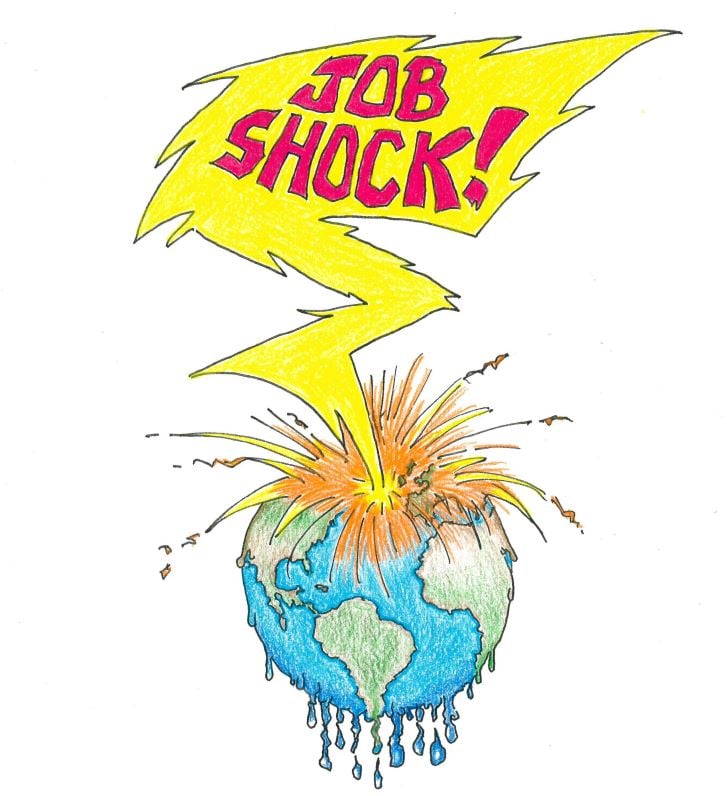
January Gordon Report: Introducing a new White Paper: Job Shock
Part I: Introduction: Why Read This?Welcome to the Fourth Industrial Revolution in a COVID-19 challenged world economy. Their combined impact on the U.S. job market will stretch to 2030 and beyond. Say hello to “Job Shock!”“Job Shock: Solving the Pandemic and 2030 Employment Meltdown” will be released as monthly topical Gordon Reports. This will give readers a greater opportunity to consider their outlook on the future of employment. “Job Shock” will present our most up-to-date research on the future of the U.S. labor market over the coming decade. We will review both long-term and short-term problems and solutions to them that are now under way across the United States. “Job Shock’s” premise is that America’s students and workers are as much in need of knowledge injections as they are of vaccine injections against COVID-19.Defining the Realities of Job ShockTechnologies that have transformed American workplaces now require higher skills. The United States is not creating more high-pay, low-skilled jobs; it is creating more high-pay, higher-skilled jobs. Unless we confront the reality of this talent mismatch, we face a decade in which there will be too many unskilled people without jobs who run a high risk for lives in poverty and too many skilled jobs without people. This potentially threatens to undermine the broader economy and increase the social disruption that has already begun.In today’s job market at least 50 percent of today’s “good jobs” (those with higher pay and benefits) do not require four-year college degrees. These jobs need students who graduate from high school with a good general educational foundation, i.e., strong reading/math comprehension, good written and verbal communication abilities, problem-solving and teamwork skills. Students then need to obtain a career certificate, apprenticeship, or a two-year degree from a technical or community college. We are not preparing enough students for the talent realities of the current U.S. job market.The United States has millions of well-educated, talented workers. But the unrelenting demands of Job Shock tells us that we will need to double their numbers over this decade to run our high-tech economy.Job Shock from COVID-19The on-going COVID-19 pandemic has only exacerbated this skills gap and sped up employment meltdowns. It caused the sharpest increase in the official U.S. unemployment rate ever recorded, rising from 3.5 percent in February 2020 to a peak of 14.7 percent in April. At the close of 2020, 12 million of the 22 million jobs lost at the start of the pandemic had been regained. The December unemployment rate of 6.7 percent reflects the number of workers permanently laid off because of the pandemic. The labor force participation rate also remains low.But the effect of COVID upon different industries and jobs has been very uneven. The leisure and hospitality sector has been particularly hard hit with its low-wage workers experiencing the greatest job loss. Payrolls for couriers and messengers have increased by over 20 percent.While many businesses lay off workers, others are struggling to fill job vacancies. Overall U.S. businesses continue to cut job training programs, further widening the skills gap. Businesses are increasing investments in automation and technologies that facilitate remote work. The continuing Fourth Industrial Revolution will further raise demands for workers with the skills needed to invent, use, maintain, or repair advanced technologies.The COVID-19 pandemic is illustrating that skill shortages can have lethal results. COVID-19 vaccine manufacturers have hundreds of vacant jobs in such areas as engineering and quality control. There are acute shortages of critical-care doctors and nurses as well as lab technicians to process COVID tests. How many of the over 400,000 dead (greater than the death toll of the U.S. armed forces in World War II) could have been saved if we had fewer shortages of medical personnel in COVID hot spots?Also, the skilled people we take for granted to meet our daily needs are in short supply. As computer systems have become more and more central to our daily lives, breakdowns and threats to the security of our private information proliferate. Finding a qualified plumber, carpenter, electrician or medical technologist has become more difficult in many communities. If more effective talent development efforts are not initiated, there is a real danger that the world will not end in a big bang, but that it will come to a slow grinding halt due to a lack of workers with the skills needed to maintain advanced technologies. Welcome to Job Shock!Job Shock ObjectivesThe goal of the “Job Shock White Paper” is to raise awareness of the broad scope of the changes needed to equip students with the education and skills needed for 21st-century jobs and careers. And we must retrain workers with the specific skills needed by employers. There are solutions already under way in communities across the United States that can help your local area. But these solutions are not easily available to all.We see the most promising responses to Job Shock coming from regional cross-sector partnerships composed of business owners and managers, educators, parents, government officials, union leaders, non-profit associations, and others. These partnerships have begun regionalized initiatives to rebuild their outdated education-to-employment systems.“Job Shock” is a call to action. We need to work together in initiating the systemic changes needed to prepare more people for better paying jobs and thus create a more equitable and prosperous economy over this decade.Part II of “Job Shock” will provide an overview of how technology has dramatically transformed workplaces and occupational requirements over the last 50 years. Unfortunately, other parts of American society have failed to adapt to these labor market changes thus contributing to the social unrest the United States is now experiencing.The monthly Gordon Report Webinars will be focusing on key topics of the “Job Shock White Paper.” For more information on signing up or viewing these webinars, click here.









